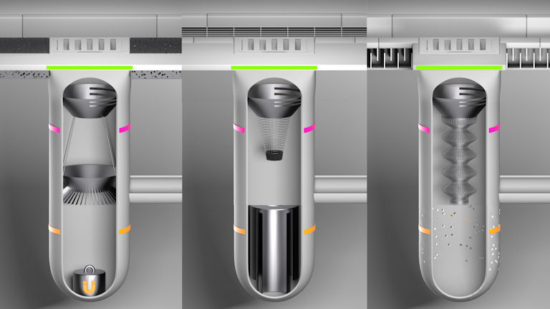Audi Environmental Foundation partnering to remove tyre wear particles from runoff
 (l-r) Combination of side inlet grille, filter skirt & sedimentation module; combination of retention space in the curb, funnel and infiltration in the shaft; combination of porous asphalt, optimised leaf basket and magnetic module (Image: Audi AG)
(l-r) Combination of side inlet grille, filter skirt & sedimentation module; combination of retention space in the curb, funnel and infiltration in the shaft; combination of porous asphalt, optimised leaf basket and magnetic module (Image: Audi AG)
The Audi Environmental Foundation is working with the Technical University of Berlin (TU Berlin) and others to develop filters for urban runoff. The goal of these filters is to prevent tyre wear particles and other environmentally harmful substances from being washed into sewers and then flowing into creeks and rivers.
Tyre and road wear particles are generated whenever vehicles are on the move. From there, it scatters into the environment with the wind, or is washed by the rain via urban runoff and sewers – usually untreated – into the soil, rivers, and oceans. Powered vehicles aren’t the sole source of these particles – the Audi Environmental Foundation notes that bicycle tyres, skateboard wheels and even shoe soles contribute to the generation of fine particles. While there is no way to completely eliminate such particles, Rüdiger Recknagel, the 2009-established foundation’s managing director, stresses that “we can do something preventively to ensure that less microplastic enters and pollutes the environment.”
Together with TU Berlin (Department of Urban Water Management) and other partners – including filter manufacturers, software developers, and water utilities – the Audi Environmental Foundation is developing optimised sediment filters for urban runoff. They catch the respective contaminant particles as close as possible to their point of origin – even before they are washed into the sewer system by rainwater. The project was launched in September 2020 and will run for a period of three and a half years.
Adaptable filters
The sediment filters have a modular design and can therefore be adapted to different road situations, traffic volumes, and other forms of pollution. In stop-and-go traffic, on a very curvy road, or at an intersection with traffic lights, for example, the constant braking and restarting causes tyres to lose more wear particles than on an unobstructed straight stretch of road. “In addition, we also want to capture as many other pollutants as possible that accumulate on and around streets – beverage cans and cigarette butts, which unfortunately often end up on the sidewalk, as well as particles that are actually natural, such as sand, leaves and pollen from trees,” says Joachim Wloka, Greenovation project manager at the Audi Environmental Foundation responsible for the Urbanfilter project.
The sediment filters are divided into three zones: street, sewer, and drain. “In total, we are developing nine different modules for different road and traffic conditions,” explains Daniel Venghaus, a research associate at the Department of Urban Water Management at TU Berlin. “Up to three different modules can then be combined from this modular system to achieve the best result depending on the location.” In the uppermost area (street), this may be a special runoff channel or appropriate asphalt. Below this, in the sewer itself, larger solids are filtered out, for example, with the aid of an optimised leaf basket or what is known as a filter skirt. The lowest area (drain) is all about fine filtration. “We’re currently testing a magnet module here,” says Venghaus. “In our preliminary tests, magnets trapped particularly fine particles without clogging.” The modules are still, for the most part, in the planning stage. Nevertheless, the partners are planning to test them in real-world scenarios before the end of the year.
Predictive maintenance
It goes without saying that the filters would have to be maintained and emptied regularly. This is where intelligent connectivity comes into play. A wealth of different information flows together for this purpose, such as the street cleaning schedule, the respective street’s traffic volume, when rush hour occurs, peak times such as the beginning and end of school breaks, as well as the weather forecast. This even includes whether there are a lot of trees or whether people frequently walk their dogs along the road. “Based on all this information, we can predict each filter’s degree of contamination and determine when the best time to empty it is. It’s basically the same idea as predictive maintenance, which is commonplace in the automotive industry,” says Wloka. “As a result, we’re connecting different sectors and applying optimised processes to a new application.”
The weather forecast plays a particularly important role in this intelligent network and makes it possible to take proactive action. Depending on the time of year, storms and rain wash a particularly large amount of debris into street drains. The filters then clog more quickly, with the result that unfiltered polluted water may be flushed into rivers and lakes via the emergency spillway. “If the weather forecast predicts heavy rain after a prolonged dry spell, we’d be able to respond immediately and have street sweepers clean the road before the downpour,” Venghaus says. This would prevent the particles from entering bodies of water and the filter could remain in use for longer.


Comments